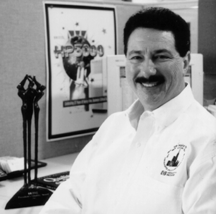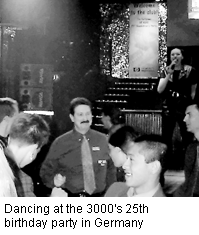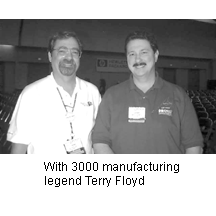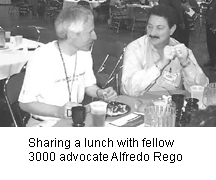 |
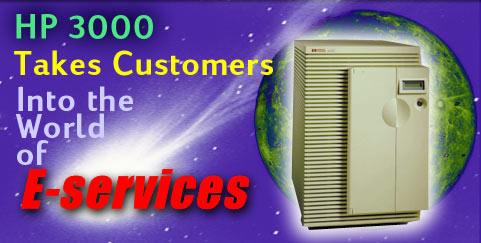 |
HP Sponsor Message |
|
|
|

Harry
Sterling General Manager, HP CSY (Retired)
|
The End of a
Career Without Limits
It’s not often you can know you’ve made a difference during a career, but for Harry Sterling, it must be a certainty. Sterling brought a humanity to his post as General Manager of the Commercial Systems Division (CSY), home of the HP 3000. Those who worked beside the man testify to his values, especially the way he valued people. Sterling made the act of inclusion his passionate mission in his time at HP, a skill that served the HP 3000 community to spark the system’s renaissance. When Sterling
took his post nearly four years ago, the HP 3000 was a different
choice for computing platforms, utterly unlike the sea of Unix
sweeping across IT beaches. He came to his post with an authentic
sense of self — the idea that being known, even for your
differences, was a path to being included. Although the strategy he
inherited for the platform didn’t emphasize its distinctions,
Sterling knew his customer base well enough to understand that those
differences were advantages. At the same time his business mission
was to get the HP 3000 accepted within HP, treated just like any
other platform HP was selling to businesses. He’d already had 20
years of HP experience on the day he became general manager, so
Sterling knew his way around the HP Way. In his final
interview before retiring from HP, Sterling also told us about his
own personal achievements that made a difference in HP. These actions
came through an HP organization called GLEN, the Gay and Lesbian
Employee Network. But even getting GLEN to be an officially
recognized HP organization took work, he reported. It also must have
taken the kind of professional courage many of us hope for in our
business lives. More than a
year ago, Sterling took his HP World speech and used it to show how
the platform was important to HP’s own IT operations — a
fact widely known in some parts of HP, but truly under the covers in
HP’s corporate message of 1998. Sterling’s speech at that
show included a compelling video interview with the HP Chief
Information Officer Mike Rose, who thanked Sterling for leading a
great division to deliver a great product. “HP has come out of
the closet and admitted that we’re using 3000s inside of
HP,” Sterling said at the time, beaming with the thrill of
making an honest showing of HP’s platform diversity. He had
lived his corporate life in the open at HP, and seemed pleased to
have the honest story told of the 3000’s contribution. It was the
kind of honesty that appears to have driven Sterling throughout his
career. Many both inside HP and out thought becoming general manager
of a division in decline was a career-limiting move. But Sterling
took his own mission of customer focus, begun during his term as the
R&D chief of the division, into his work as General Manager,
evangelizing the idea that relationships with customers are key to
knowing what to build and sell them. The mission paid off with a
rebound in the platform’s fortunes: Sales returned to
decade-long high marks after many predicted the 3000 wouldn’t
make it beyond 2000. Sterling proves in his interview that his heart
has led him beyond any limits, the same passion to include that won
the HP 3000 a place again at HP’s table. There are two things that come to mind. One is the customer focus activities that I led five years ago with the R&D organization, and the fact that’s now being recognized and it’s being leveraged across other parts of HP. The second thing
was the involvement I had with other HP people to help get
domestic-partner benefits for Hewlett-Packard. There were 12 lesbians
and gay men, and one straight woman, who went before the HP Executive
Committee, which is Lew Platt’s direct reports. We basically
spent an hour talking about what it’s like being gay in
Hewlett-Packard, and why we felt we should be extended
domestic-partner benefits. That made a big difference in helping us
to get that three months later. We had a Reader’s Theatre, where we threaded through each of our stories, taking turns in talking about personal experiences. Mine primarily was mostly positive, by the way, in terms of how I had been treated as a gay employee by my managers. That wasn’t the case for everyone, but I wanted to make sure that was represented as well. On a personal
front, it was a very risky thing to do. As a matter of fact, I
believe I started my talk out by saying, “Do you ever have those
moments in your life where you stop and think that what you’re
about to do may be a career-limiting move?” I said, “This
is that point for me.” That was a personal risk and reward I
had. In terms of a risk from a professional point of view, it was the customer focus, because it really was having to change a culture and view of an organization. That’s very hard to do, and it required a lot of persistence on my part. In some cases feeling — other than for the support of my manager [General Manager Oliver Helleboid] — it felt like it was me and them. I don’t particularly like being in those situations, but you get to the point where you tell people, “This is the way it’s gonna be, and if you don’t like it, get out.” That’s the message I had to deliver to get people understanding I was serious about it. So you think
you’d like that customer focus to be the thing you’re
remembered for in HP? You create loyalty with your customers, and that causes them to come back and buy again. I think it’s directly related to the corporate objectives. I just think that parts of HP have gotten so hung up on the revenue and profit side that they’ve forgotten about the value side, providing the value. That causes your profits to be more lucrative, because you’re creating more value. In terms of the domestic partner benefits, I think it was part of the essence of the HP Way, if you really read it. It talks about having a respect for people and creating a positive work environment, and in return, people will excel if you do that. Well, one of the things about having a positive work environment is to feel included. So if you exclude some of your employees from benefits, then you don’t feel included. This causes you to not be who you are, and have resentment and can create a negative view of the workplace. I just helped let
our managers know that we didn’t feel included. In simple little
things like the policy for the company cars was that a spouse could
drive the company car, so long as the HP employee was in the car with
them, like if they were going on vacation or taking someone to the
airport. It excluded domestic partners. So simple little things like
that caused us to feel excluded. Yes, but
that’s just an annoyance. Other things like medical benefits are
not annoyances, and caused a lot of out-of-pocket expenses. For
somebody who can choose to be married under a legal system, it’s
not the same to them. It was one month
after I’d been named general manager of CSY. A lot of HP’s
position at the time was that the managers just weren’t aware of
what was happening, and how people felt. It was a very cordial, very
understanding meeting. There were a lot of questions of
clarification, and sensitivity on the part of the managers, and a lot
of support. Lew Platt was supportive, as was his staff. I think I was. [When HP made the changes 90 days later], it was all inclusive. Every place they could include us, they did. There were a few cases where because of federal regulations things had to be handled differently. All of our medical coverage, every place in the company policies where it said “Spouse” it now says “Spouse/domestic partner.” And it wasn’t just for gay relationships. It was for any domestic partner relationship, whether it be for a man and woman, or two men, or two women. It’s one of
the things I saw immediately when I joined HP 24 years ago that I had
not seen in the two other places where I had worked: this respect for
people that HP has. I worked for an engineering company of 400 people
in Virginia, and it was primarily government contract work in the
Washington D.C. area, so it’s what you would expect. I headed up
the systems programming staff. If you know anything about IBM
mainframes, it’s the gurus and priestesses who keep that system
going. One of the things
that happened in the last two years was that we went to looking at
the 3000 business by the entire value chain. That’s something
that my team and I gathered all the information about: the revenues
for the entire business, not just the server hardware part of it. We
basically have put together a process where we’re now tracking
profitability for the total business, and making that visible to
managers on a quarterly basis. Yes. We
haven’t changed any of our measurements, other than we’re
making that information visible and acknowledging and having our
managers see that we are making investments that in many cases
benefit other parts of the business that we don’t get financial
credit for. But it is the right thing to do for the business. For
example, last year, in refreshing all of the education programs, we
actually did that out of our [CSY] investment dollars. But the
education group was the one to get the revenue for that. We’ve
included that in our total business picture now. We’ve put
together measures to look at the total business. That’s one way
that I made a change. I can tell you what things were a blindside for me, a tough part of learning, and that was the whole marketing and channel piece. I didn’t have a lot of experience with it, and it required a lot of energy. I was very sensitive about hiring a marketing manager who had that skill, who was Roy [Breslawski] at the time. I think what really is still key with the 3000 is keeping the R&D organization motivated, and keeping the linkage with the customers. The thing that does all that is the technical dimension. I think being the GM and coming from the technical side I probably was able to influence the R&D organization more so than somebody who did not understand R&D. In the past there were GMs who effectively told me right out, “I don’t understand R&D, I don’t want to be involved in the details; I’m leaving that up to you.” That’s great, except that sometimes you feel kind of out in left field, and maybe a little unappreciated if your GM doesn’t know something about what you’re doing. I think that maybe helped to continue to move the R&D organization a little faster, and be a little more focused in what we did. They would take my suggestions and ideas and work through them maybe a little more quickly from someone who didn’t understand it. This is all speculation on my side; you’d probably have to ask some of the R&D folks if that’s the case. I probably was
able to create credibility with a lot of the customers faster, coming
from the R&D side — because a lot of our customers are
techies. I brought a certain respect to the position, but this again
is speculation. I’m putting words in people’s mouths. I think
throughout my career I’ve been very sensitive in helping to
bring along people who report to me, to get them to a position to
take my place. It’s something I always appreciated having happen
for me. Olivier Helleboid did that thing for me, one year before I
became the GM. He took me on a customer tour of Europe when he was
presenting at user group meetings. We basically split the
presentation half and half. That was his way of getting me out in the
field, getting to know the customers. He did that for me, and I did
that for Winston. Because it had been done for me, it really helped
position me for the next level, so I felt I needed to do that as
well. I’ve always done that with my staff, encourage them to
take on some of my job. I’m very good at delegating. I try to
give people things to that would be the next level up. It came out of necessity. We only had a certain number of dollars we were able to invest, and still remain profitable. It was a really hard set of things in front of us that we could afford to do. We were always, and still are, in a constant state of having to prioritize our investments. Working directly with customers had helped us understand which were those critical things. Indeed, in many cases we had customers prioritize for that. That’s where the Special Interest Groups helped a lot, in some of our technology prioritization. I think what’s happened now in the last couple of years with our ISVs is that we’re starting to build better relationships with them. That’s out of two things: One, I don’t want to do things that one of our ISVs is doing, and effectively put them out of business or take business away from them. The second thing is that if we can have partners working with us to provide more functionality, and we can share in the wealth of doing that together, then the bottom line is that it gives our customers more than they would have got. Frankly, I have turned a deaf ear in some of these situations with customers, because frankly, they want something for nothing. And they think, “If HP did it, it would be part of the operating system and we wouldn’t have to pay for it.” Well, the hard and fast fact is we have to come up with investment dollars out of profit and revenue. So we can’t afford to do all this stuff for nothing. Frankly, there
were several situations where I knew if we did the functionality, and
attempted to sell it as an option, which we’d done in the past,
the customers would simply choose not to buy it, and continue to
pound on us and say it should be free. If we had a partner do it and
had the partner sell it, the customer seems to be more ready to pay
for it. They have this thing that they buy the hardware from us, and
there’s no value in the software to them. That was the direction
we went. Any added value in software above the base we prefer our
partners do that. It frees us up to do the operating system stuff,
and it gives the partners a revenue stream. In one case I canceled the whole ODBC driver project. Originally we were going to charge for it. Then it became very clear the customers were not willing to pay for it at the level we would have had to charge for it. It was halfway implemented, and I said “We’re not going to do this. It’s clear the customers are not going to pay for it. They want it free.” That’s when we started negotiating with Birket [Foster of M.B. Foster Associates for ODBCLink/SE]. We said hey, if you sell this and build stuff on top of it, be willing to contribute the base driver in FOS, we’ll put that out there for nothing, and you can sell products on top of it. I could see we
were going to have another year of investment, and no revenue for
that. I rechanneled those engineers back into networking, which was
more critical for us at the time. I’m trying
to think if it’s anything different than the ongoing challenges
we always have: more to do than we have dollars to invest. I guess I
would say two things. Getting through this hump of the next [N-Class]
platform successfully is the first thing. The second is making sure
the 3000 message continues to be part of the e-service message from
HP. I don’t
really have anything. The job I’ve had for the past four years,
the satisfaction that I get, is not in the delivery of the products.
That was something I was really excited about when I was the R&D
manager. From the business point of view I think I finished
everything I needed to finish for this phase. The platform is
positioned well from a measurement point of view. We have a good road
map in place to carry us for the next three to five years. We know
where our staffing levels are, and how we’re going to execute on
that. I don’t feel I have any major loose ends. Sure, there are
products that aren’t completed. It would have been nice to have
been around when we get to the next generation platforms, and when
IA-64 gets released. But I frankly don’t get the same kicks out
the product introductions that I used to. It’s more that the
business is in a good state, we have good relationships with our
customers, the employees have high morale right now. What more could
I ask for? You’ve written something about this in the past, where sometimes I will come to certain conclusions with my own frame of reference. Then with more information I will change my mind. I think that’s what happened. When I came into the job I was told the 3000 was not going to be around but for another three or four years. That it wasn’t clear at that point that we should make the IA-64 investment. I knew that going into the job that was one of the decisions I was going to have to make and communicate, whether we were going to do it or not. I attempted to postpone that decision for a couple of years, until I thought it was a critical time from a technology decision point of view, where we had to start working on it. Or from a customer intolerance point of view, where they said “We need long-term plans, and you’ve got to tell us what’s going to happen in the next five years.” After I talked with some of our larger customers, they told us it would take three to five years for some of them to make those kinds of changes. And they needed that kind of visibility. I forced the issue upward, putting together three or four different scenarios — if we didn’t do it, if we did do it. Having gone
through that, and having the information about the customers needing
the planning horizon, I forced myself to make a recommendation to
Glenn Osaka, who was the group manager. The GMs for the Unix business
supported the decision. The recommendation was that we announce
it. I spent three months talking to our major accounts, went and visited them and we tried out a couple of scenarios under non-disclosure. I talked to some industry consultants, and I talked to Rich Sevcik, who at that point had the Unix business. I remember in particular one analyst who said, “I don’t know how you could not decide to do IA-64. If you didn’t it would hurt your overall image with your customers. It would even potentially affect your Unix business. Your competitors could use it against you. And besides, it’s very profitable. How could you not make this decision?” It was a no-brainer. With all that
information, all that was left to me was to package it all up and
inform everyone we were going to go forward. The loyal
customers. They’ll keep us on the right track, so long as we
stay connected to them. The people in HP,
and the customers. I was helping to draft my last article, and I was
going back on memory lane, thinking about the first time I met Birket
Foster, and COBOL SIG leader Jeanette Nutsford. I was thinking about
those kinds of people and how they’ve almost become friends to
me. When I see them, it’s more than just a business association.
I’m going to miss that, and going to HP World and seeing all the
faces and talking to the people. It’s the people I’m going
to miss. That’s really all, the people. |
Copyright The 3000 NewsWire. All rights reserved.
